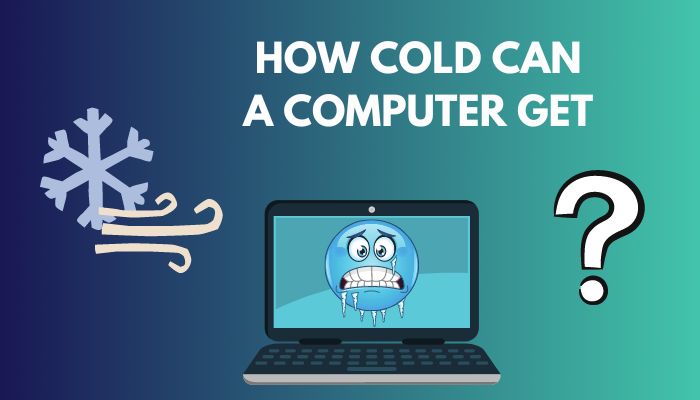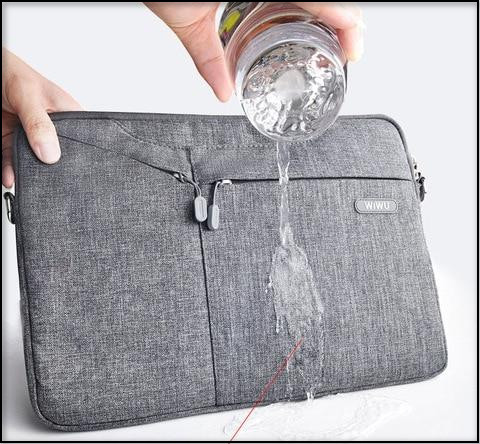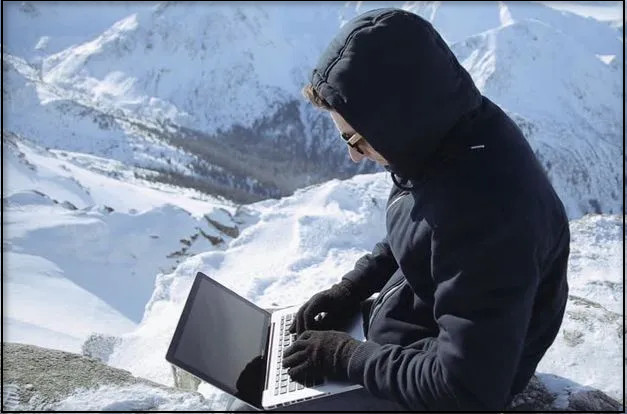Generally, a computer or laptop can get damaged due to high and low temperatures.
But do you know how cold a computer can get and still work perfectly?
In this article, you will find the answer to that question. Moreover, I will discuss what you should do to protect your laptop from extreme cold weather.
Without further ado, let’s begin.
How Cold Can a Computer Get?
Generally, there is no specific temperature range at which a computer fails to work. But most of the computers are built to work at 40 to 100° Fahrenheit (5 to 38° celsius). Depending on their build quality, some devices may work even at higher or lower temperatures.
So, what is the lowest temperature a laptop can handle?
I’ve used and tested almost 15-20 laptops and discovered that they could function at temperatures as low as 40 to 50° F (4 to 10° C). They can function at hot temperatures of 95 to 100° F (35 to 38° C).
If you live in a state where the temperature goes below zero degrees, you should not take it outside too often. The laptop battery, the monitor screen and hardware components will get defective if you do that.
Related contents you should read about Computer taking forever to Restart.
Is It Bad for a Computer to Get Cold?
A slight bit of a cold is not that bad for a computer. If the device is too cold than its surroundings, you should be anxious about your computer. When this happens, condensation occurs inside your PC. The moisture within the air turns into a small drop of water.
As you know, water is not good for any electrical devices. This formed water can easily cause damage to the hardware, and you may end up losing your precious computer device.
You may aware of the fact that a laptop or a computer produces too much heat while it operates. When there is excessive heat in the system and its surroundings, it starts to operate slowly. The computer will run way smoother and quicker while it is cool, and it will be easier for you then to play any high-graphics game or use any heavy software. That’s why it is said the colder the device is, the faster and better it will run.
How to Protect Your Laptop From Cold Weather
Although using a laptop in cold conditions is good, in excessive cold, it’s not. You should be careful with your laptop if you live or move into a place like Minnesota, Vermont, Montana etc. Follow these methods to protect your laptop from getting defective in colder conditions.
Check out the easiest way to know about Computer Beeps 4 Times On Startup.
Here are the ways to protect your laptop from cold weather:
Use Waterproof Laptop Bag
A laptop bag is very effective in giving protection from cold weather conditions. With a normal laptop bag, moisture can easily find its way in and can damage the laptop’s hardware. My advice for you is to buy a waterproof bag. This will not only help the laptop to give protection from the snow but also help the device keep warm.
My advice for you is to buy a waterproof bag. This will not only help the laptop to give protection from the snow but also help the device keep warm.
Don’t be cheap when you buy a laptop bag. To save some bucks, it is not worth risking your expensive laptop.
Allow Your Laptop to Warm Up Itself
While you enter your office or home with your laptop after roaming outside in cold conditions, don’t turn on your laptop promptly. If you do, a condenser situation will create inside your computer and lead to your PC to permanent damage.
Wait a while, like twenty to thirty minutes and let your device warm-up itself. When the laptop’s temperature adjusts with the room condition, it will be a good time for the laptop to turn on.
Don’t try to warm your laptop with a hair dryer. It is a dumb idea if you think about it.
But before that, go through our epic guide on will Factory Resetting a Computer make it faster?
Never Leave a Laptop in a Cold Place
No matter what you do, never leave your laptop in a car or a chilly environment. Sometimes an excellent laptop bag can’t perfectly protect the laptop from the heavy snowfall which was left in the vehicle. A little bit of snowflake or freezing air will find a way to get through and damage the internal system. Take your laptop while you go inside a building or house or in a warmer place. If you are in a hurry, leave your laptop in a warm place like your home or in a locker if possible. The risk of the laptop getting damaged will go lower.
Take your laptop while you go inside a building or house or in a warmer place. If you are in a hurry, leave your laptop in a warm place like your home or in a locker if possible. The risk of the laptop getting damaged will go lower.
Avoid using a laptop in Cold Temperatures
Sometimes you may use your laptop in a comfortable way, like keeping it on your lap or bed or floor or even on the balcony. However, if you start using the laptop while sitting outside in a 30 to 40 degrees Fahrenheit environment, it would not be a smart idea.
However, if you start using the laptop while sitting outside in a 30 to 40 degrees Fahrenheit environment, it would not be a smart idea.
The possibility of draining the battery life, especially lithium-ion batteries, increases while you continuously keep doing it. Avoid using your laptop on the balcony, unheated garages or attic spaces. Use your laptop indoors as much as possible.
Also, check out our separate post on my Computer is Frozen and won’t turn off.
FAQs
What temp is too cold for a PC?
Generally, around 35 to 40 degrees F is too cold for a PC. If the PC reaches around this temperature, its operating system starts to fail and sometimes it gets turned off.
Is it safe to carry laptop in cold weather?
No, it is not safe to carry a laptop in cold weather. Because the cold can freeze the laptop and damage the laptop’s internal function. And you may end up losing all your valuable data. If you are too desperate to take the laptop outside, ensure it gets a warm-up before turning it on.
How can I protect my laptop from cold?
Use a waterproof bag to protect your laptop from the cold. Besides, you can keep your laptop in a well-preserved and insulated case. It will give your laptop protection from getting wet.
Final Thought
Try to keep your PC temperature under 130 – 140° F. At this temperature, the PC works without a hitch.
Additionally, don’t keep any objects in the laptop’s or PC’s air-out area. If you do, heavy heat will generate and damage your internal components.
If you have any queries, comment below.



